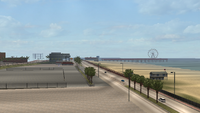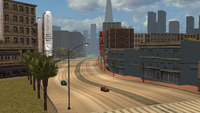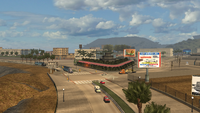California: 18 Wheels of Steel
California is a state of the United States, which is featured in the 18 Wheels of Steel series.
Summary
The state is bordered by the Pacific Ocean to the west, Oregon to the north, the Mexican state of Baja California to the south, and Nevada and Arizona to the east.
Geography
California is located in the Western coast of the United States. It is bordered by the Pacific Ocean to the west, Oregon to the north, the Mexican state of Baja California to the south, and Nevada and Arizona to the east. With an area of 163,696 square miles (423,970 km2), California is among the most geographically diverse states. The Sierra Nevada, the fertile farmlands of the Central Valley, and the arid Mojave Desert of the south are some of the major geographic features of this U.S. state. It is home to some of the world's most exceptional trees: the tallest (coast redwood), most massive (Giant Sequoia), and oldest (bristlecone pine). It is also home to both the highest (Mount Whitney) and lowest (Death Valley) points in the 48 contiguous states. The state is generally divided into Northern and Southern California, although the boundary between the two is not well defined. San Francisco is decidedly a Northern California city and Los Angeles likewise a Southern California one, but areas in between do not often share their confidence in geographic identity.
Geographically, the state can be divided into eight regions, from north to south: the Klamath Mountains, the Coastal Ranges, the Sierra Nevada, the Central Valley, the Cascade Mountains, the Basin and Range Province, the Los Angeles Ranges, and the San Diego Ranges.
The Klamath Mountains is in the northwest corner of the state. They are comprised of many small forest covered ranges and are higher than the coastal mountains to the south. Many mountains range from about 6,000 to 8,000 feet (1,828 m to 2,438 m) above sea level. The small ranges are separated by deep canyons.
The Coastal Ranges in the north reach inland 20 to 30 miles (32 to 48 km) extend from the Klamath Mountains in the north south to Santa Barbara. The Coastal Ranges include many smaller chains of mountain ranges including the Diablo and Santa Cruz Mountains. Some of the valleys separating these ranges are the Napa Valley, north of San Francisco and the Santa Clara and Salinas Valleys to the south. The Coastal Range is home to California's legendary Redwoods and, less fortunately the San Andreas Fault. The San Andreas Fault enters California from the Pacific Ocean near Port Arena and extends southeast into the state. Earthquakes are caused by movement of the earth's crust along this fault.
The Sierra Nevada mountain range in the east runs about 430 miles (692 km) from north to south and forming a giant wall rising to over 14,000 feet (4,267 m). The range varies from around 40 to 70 miles (64 to 112 km) wide. Many peaks in the range reach over 14,000 feet (4,267 m) above sea level, with Mt. Whitney, at 14,494 feet (4,417 m), the highest peak in the United States south of Alaska. Mountain streams and glacial action have cut deep valleys into the western part of the Sierras. Yosemite Valley is one of the most spectacular of these valleys.
The Central Valley lies between the Coastal Range and the Sierra Nevada range and is home to the San Joaquin and Sacramento rivers. Sometimes called the Great Valley, the Central Valley is about 450 miles (724 km) long from points in the northwest to the southeast. A level, broad fertile plain, the Central Valley is the most important farming area west of the Rocky Mountains and comprises about three-fifths of California's productive farmland.
The Cascade Mountains extend north from the Sierra Nevada mountain range. They were formed by volcanoes unlike the other mountain ranges in California and support one still-active volcano; Lassen Peak. Lassen is 10,457 feet (3,187 m) high and located in the southern Cascades. The Cascade Mountains are also home to Mt. Shasta, once and active volcano. Mt. Shasta rises 14,162 feet (4,317 m) above sea level.
The Basin and Range Province contain the southeastern deserts of California. It is part of a large region that extends into Nevada, Oregon, and other states. In the north, much of the area is a lava plateau. This was formed thousands of years ago when the region was flooded with molten lava flowing out of cracks in the earth's surface. In the south, a good deal of the area is wasteland and includes the Mojave Desert and the Colorado Desert. Death Valley lies near the California-Nevada border and features some of the most inhospitable territory in the world. Some areas of the Basin and Range Region have been made quite productive, however, due to large irrigation projects that have made farming feasible. Two of these areas are the Imperial and the Coachella Valleys near the California border with Mexico.
The Los Angeles Ranges, between Santa Barbara and San Diego counties, are a group of small mountain ranges that extend east to west. Because of this general east-west direction, the Los Angeles Ranges are sometimes called the Transverse Ranges. Most mountain ranges in California run generally from north to south. Included in the Los Angeles Ranges are the Santa Ynez, Santa Monica, San Gabriel, and San Bernardino mountains. Sometimes the San Jacinto and Santa Ana Mountains are included as part of the Los Angeles Ranges.
The San Diego Ranges cover most of San Diego county in the southwestern corner of California. These mountains, sometimes called the Peninsular Ranges, include the Agua Tibia, Laguna, and Vallecito mountains and extend southward into the Mexican peninsula known as Baja California.
Climate
The climate of California varies widely from hot desert to alpine tundra, depending on latitude, elevation, and proximity to the Pacific Coast. California's coastal regions, the Sierra Nevada foothills, and much of the Central Valley have a Mediterranean climate, with warmer, drier weather in summer and cooler, wetter weather in winter. The influence of the ocean generally moderates temperature extremes, creating warmer winters and substantially cooler summers in coastal areas.
Cities
There are 3 cities in California, represented in the 18 Wheels of Steel series.
Los Angeles and San Francisco were included in all of the 18 Wheels of Steel games. While Santa Cruz was also included in Convoy, Haulin', and American Long Haul.
| City Name | Image | First Game | Remarks |
|---|---|---|---|
| Los Angeles | 
|
Hard Truck: 18 WoS | |
| San Francisco | 
|
Hard Truck: 18 WoS | |
| Santa Cruz | 
|
18 WoS: Convoy |
See also
| The States of 18 Wheels of Steel | |
|---|---|
Alabama - Arizona - California - Colorado - Florida - Georgia - Idaho - Illinois - Indiana - Iowa - Kansas - Kentucky - Louisiana - Massachusetts - Michigan - Minnesota - Missouri - Montana - Nevada - New Mexico - New York - North Dakota - Ohio - Oklahoma - Pennsylvania - South Carolina - Tennessee - Texas - Utah - Washington - Wyoming |
